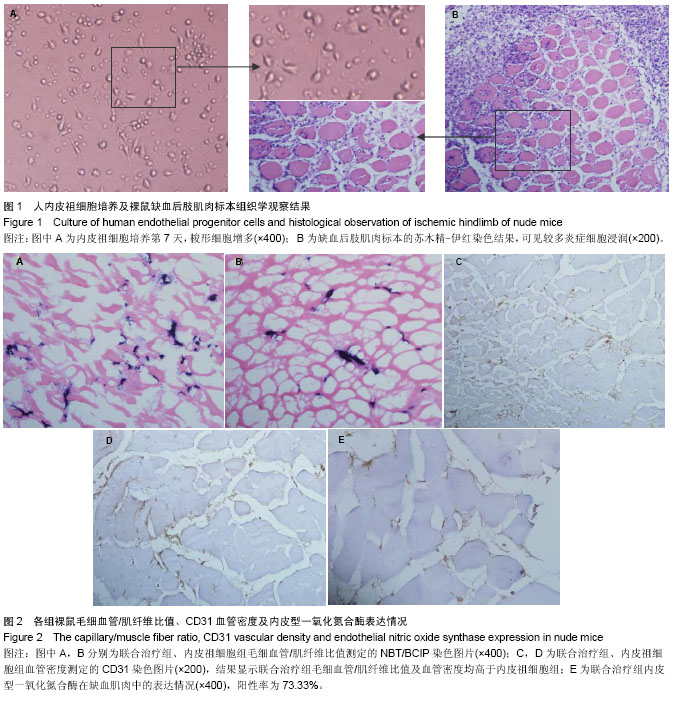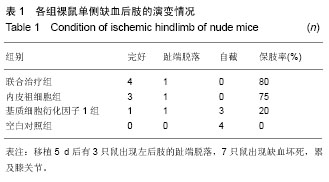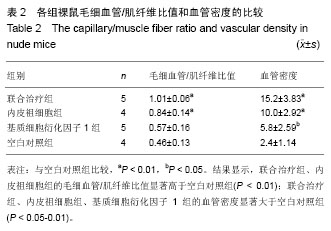| [1] Norgren L, Hiatt WR, Dormandy JA, et al. Inter-society consensus for the management of peripheral arterial diseases. J Vasc Surg. 2007; 1(suppl):S5A-S67A.
[2] Hill JM, Zalos G, Halcox JPG, et al. Circulating endothelial progenitor cells, vascular function and cardiovascular risk. N Engl J Med. 2003; 348:593-600.
[3] Tateishi-Yuyama E, Matsubara H, Murohara T, et al. Therapeutic angiogenesis for patients with limb ischemia by autologous transplantation of bone-marrow cells: a pilot study and a randomised controlled trial. Lancet. 2002; 360: 427-435.
[4] Iwaguro H, Yamaguchi J, Kalka C, et al. Endothelial progenitor cell vascular endothelial growth factor gene transfer for vascular regeneration. Circulation. 2002; 105: 732-738.
[5] Murohara T, Ikeda H, Duan J, et al. Transplanted cord blood-derived endothelial precursor cells augment postnatal neovascularization. J Clin Invest. 2000; 105:1527-1536.
[6] Sakamoto M, Nakamura T, Torimura T, et al. Transplantation of endothelial progenitor cells ameliorates vascular dysfunction and portal hypertension in carbon tetrachloride-induced rat liver cirrhotic model. J Gastroenterol Hepatol. 2013;28(1):168-178.
[7] Peichev M, Naiyer AJ, Pereiva D, et al. Expression of VEGFR-2 and AC133 by circulating human CD34+ cells identifies a population of functional endothelial precursors. Blood. 2000; 95:952-958.
[8] 吴元兵,王玉琦,符伟国,等.基质细胞衍化因子-1对人内皮祖细胞迁移的影响[J].基础医学与临床,2009,29(3):283-286.
[9] 李泳雪,林松,陆晓,等.生理性缺血训练对冠心病患者循环血管内皮祖细胞的影响[J].中国康复医学杂志, 2012,27(4): 293-299.
[10] Ward MR, Thompson KA, Isaac K, et al. Nitric oxide synthase gene transfer restores activity of circulating angiogenic cells from patients with coronary artery disease. Mol Ther. 2011; 19(7): 1323-1330.
[11] Vasa M, Fichtlscherer S, Aicher A, et al. Number and migratory activity of circulating endothelial progenitor cells inversely correlate with risk factors for coronary artery disease. Circ Res. 2001;89:E1-7.
[12] Huang P, Huang S, Chen Y, et al. Increases circulating CD31+/annexin V+ apoptotic microparticles and decreased circulating endothelial progenitor cell levels in hypertensive patients with microalbuminuria. J Hypertens. 2010;28(8): 1655-1665.
[13] Yamaguchi J, Kusano KF, Masuo O, et al. Stromal cell-derived factor-1 effects on ex vivo expanded endothelial progenitor cell recruitment for ischemic neovascularization. Circulation. 2003;107:1322-1328.
[14] Segal MS, Shah R, Afzal A, et al. Nitric oxide cytoskeletal-induced alterations reverse the endothelial progenitor cell migratory defect associated with diabetes. Diabetes. 2006; 55:102-109.
[15] Nakamura Y, Ishikawa H, Kawai K, et al. Enhanced wound healing by topical administration of mesenchymal stem cells transfected with stromal cell-derived factor-1. Biomaterials. 2013;34(37):9393-9400.
[16] Yu J, Li MC, Qu ZL, et al. SDF-1/CXCR4-mediated migration of transplanted bone marrow stromal cells toward areas of heart myocardial infaction through activation of PI3K/Akt. J Cardiovasc Pharmacol. 2010; 55:496-505.
[17] Zheng H, Dai T, Zhou BQ, et al. SDF-1α/CXCR4 decreases endothelial progenitor cells apoptosis under serum deprivation by PI3K/AKT/eNOS pathway. Atherosclerosis. 2008;201:36-42.
[18] Macarthur JJ, Cohen JE, McGarvey J, et al. Preclinical evaluation of the engineered stem cell chemokine stromal cell-derived factor 1-alpha analogue in a translational ovine myocardial infarction model. Circ Res. 2013.
[19] Virani S, Edwards AK, Thomas R, et al. Blocking of stromal cell-derived factor-1 reduces neoangiogenesis in human endometriosis lesions in a mouse model. Am J Reprod Immunol. 2013;70(5):386-397.
[20] Asahara T, Murohara T, Sullivan A, et al. Isolated of putative progenitor endothelial cells for angiogenesis. Science. 1997; 275:964-967.
[21] Hiasa K, Ishibashi M, Ohtani K, et al. Gene transfer of stromal cell-derived factor-1 enhances ischemic vasculogenesis and angiogenesis via vascular endothelial growth factor/endothelial nitric oxide synthase-related pathway. Next-generation chemokine therapy for therapeutic neovascularization. Circulation. 2004; 109: 2454-2461.
[22] Zhou J, Cheng M, Liao YH, et al. Rosuvastatin enhances angiogenesis via eNOS-dependent mobilization of endothelial progenitor cells. PLoS One. 2013;8(5):e63126.
[23] Cui B, Huang L, Fang Y, et al. Transplantation of endothelial progenitor cells overexpressing endothelial nitric oxide synthase enhances inhibition of neointimal hyperplasia and restores endothelium-dependent vasodilatation. Microvasc Res. 2011;81(1):143-150.
[24] Chen X, Gu M, Zhao X, et al. Deterioration of cardiac function after acute myocardial infarction is prevented by transplantation of modified endothelial progenitor cells overexpressing endothelial NO synthases. Cell Physiol Biochem. 2013;31(2-3):355-365.
[25] Kawamoto A, Iwasaki H, Kusano K, et al. CD34-positive cells exhibit increased potency and safety for therapeutic neovascularization after myocardial infarction compared with total mononuclear cells. Circulation. 2006; 114: 2163- 2169.
[26] De Falco E, Porcell P, Torella AR, et al. SDF-1 involvement in endothelial phenotype and ischemic-induced recruitment of bone marrow progenitor cells. Blood. 2004; 104:3472- 3482.
[27] Jujo K, Ii M, Sekiguchi H, et al. CXC-chemokine receptor 4 antagonist AMD3100 promotes cardiac functional recovery after ischemia/reperfusion injury via endothelial nitric oxide synthase-dependent mechanism. Circulation. 2013;127(1): 63-73.
[28] 吴春朋,张潜,方宁,等.骨髓间充质干细胞移植促进糖尿病大鼠后肢缺血血管的新生[J].中国组织工程研究, 2012,16(1): 76-80.
[29] Fuster V, Sanz J. Gene therapy and stem cell tnerapy for cardiovascular disease today: a model for translational research. Nat Cli Pract Cardiovas Med. 2007;4(suppl 1): 1-8.
[30] Kalka C, Masuda H, Takahashi T, et al. Vascular endothelial growth factor(165) gene transfer augments circulating endothelial progenitor cells in human subjects. Circ Res. 2000; 86:1198-1202.
[31] Brunt KR, Wu J, Chen Z, et al. Ex vivo Akt/HO-1 gene therapy to human endothelial progenitor cells enhances myocardial infarction recovery. Cell Transplant. 2012;21(7): 1443-1461.
[32] Wang Y, Yan W, Lu X, et al. Overexpression of osteopontin induces angiogenesis of endothelial progenitor cells via the avβ3/PI3K/AKT/eNOS/NO signaling pathway in glioma cells. Eur J Cell Biol. 2011;90(8):642-648.
[33] MacArther JW, Purcell BP, Shudo Y, et al. Sustained release of engineered stromal cell-derived factor 1-α from injectable hydrogels effectively recruits endothelial progenitor cells and preserves ventricular function after myocardial infarction. Circulation. 2013;128(11 Suppl 1):S79-86.
[34] Sobhan PK, Seervi M, Joseph J, et al. Immmortalized functional endothelial progenitor cell lines from umbilical cord blood for vascular tissue engineering.Tissue Eng Part C Methods. 2012;18(11):890-902.
[35] Nakamura Y, Ishikawa H, Kawai K, et al. Enhanced wound healing by topical administration of mesenchymal stem cells transfected with stromal cell-derived factor-1. Biomaterials. 2013;34(37):9393-400.
[36] Plummer PN, Freeman R, Taft RJ, et al. MicroRNAs regulate tumor angiogenesis modulated by endothelial progenitor cells. Cancer Res. 2013;73(1):341-352.
[37] Tecilazich F, Dinh T, Pradhan-Nabzdyk L, et al. Role of endothelial progenitor cells and inflammatory cytokines in healing of diabetic foot ulcers. PLoS One. 2013;8(12):e83314. |


